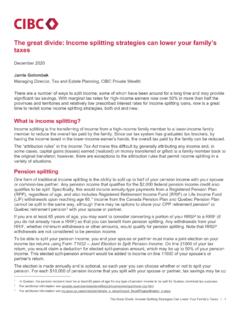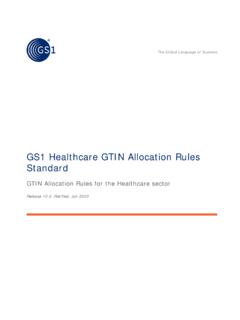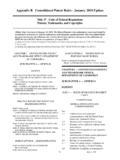Transcription of Additional Guidance on the Attribution of Profits to ...
1 Additional Guidance on the Attribution of Profits to Permanent Establishments BEPS ACTION 7 March 2018 OECD/G20 Base Erosion and Profit Shifting Project Additional Guidance on the Attribution of Profits to Permanent Establishments, BEPS Action 7 INCLUSIVE FRAMEWORK ON BEPS 2 This document and any map included herein are without prejudice to the status of or sovereignty over any territory, to the delimitation of international frontiers and boundaries and to the name of any territory, city or area. Please cite this publication as: OECD (2018), Additional Guidance on the Attribution of Profits to Permanent Establishments, BEPS Action 7, You can copy, download or print OECD content for your own use, and you can include excerpts from OECD publications, databases and multimedia products in your own documents, presentations, blogs, websites and teaching materials, provided that suitable acknowledgement of OECD as source and copyright owner is given.
2 All requests for public or commercial use and translation rights should be submitted to Requests for permission to photocopy portions of this material for public or commercial use shall be addressed directly to the Copyright Clearance Center (CCC) at or the Centre fran ais d exploitation du droit de copie (CFC) at 3 Additional Guidance ON THE Attribution OF Profits TO PERMANENT ESTABLISHMENTS, BEPS ACTION 7 OECD 2018 Foreword The integration of national economies and markets has increased substantially in recent years, putting a strain on the international tax rules , which were designed more than a century ago. Weaknesses in the current rules create opportunities for base erosion and profit shifting (BEPS), requiring bold moves by policy makers to restore confidence in the system and ensure that Profits are taxed where economic activities take place and value is created.
3 Following the release of the report Addressing Base Erosion and Profit Shifting in February 2013, OECD and G20 countries adopted a 15-point Action Plan to address BEPS in September 2013. The Action Plan identified 15 actions along three key pillars: introducing coherence in the domestic rules that affect cross-border activities, reinforcing substance requirements in the existing international standards, and improving transparency as well as certainty. After two years of work, measures in response to the 15 actions were delivered to G20 Leaders in Antalya in November 2015. All the different outputs, including those delivered in an interim form in 2014, were consolidated into a comprehensive package. The BEPS package of measures represents the first substantial renovation of the international tax rules in almost a century.
4 Once the new measures become applicable, it is expected that Profits will be reported where the economic activities that generate them are carried out and where value is created. BEPS planning strategies that rely on outdated rules or on poorly co-ordinated domestic measures will be rendered ineffective. Implementation is now the focus of this work. The BEPS package is designed to be implemented via changes in domestic law and practices, and via treaty provisions. With the negotiation for a multilateral instrument (MLI) having been finalised in 2016 to facilitate the implementation of the treaty related measures, 67 countries signed the MLI on 7 June 2017, paving the way for swift implementation of the treaty related measures. OECD and G20 countries also agreed to continue to work together to ensure a consistent and co-ordinated implementation of the BEPS recommendations and to make the project more inclusive.
5 Globalisation requires that global solutions and a global dialogue be established which go beyond OECD and G20 countries. A better understanding of how the BEPS recommendations are implemented in practice could reduce misunderstandings and disputes between governments. Greater focus on implementation and tax administration should therefore be mutually beneficial to governments and business. Proposed improvements to data and analysis will help support ongoing evaluation of the quantitative impact of BEPS, as well as evaluating the impact of the countermeasures developed under the BEPS Project. As a result, the OECD established an Inclusive Framework on BEPS, bringing all interested and committed countries and jurisdictions on an equal footing in the 4 Additional Guidance ON THE Attribution OF Profits TO PERMANENT ESTABLISHMENTS, BEPS ACTION 7 OECD 2018 Committee on Fiscal Affairs and all its subsidiary bodies.
6 The Inclusive Framework, which already has more than 100 members, will monitor and peer review the implementation of the minimum standards as well as complete the work on standard setting to address BEPS issues. In addition to BEPS Members, other international organisations and regional tax bodies are involved in the work of the Inclusive Framework, which also consults business and the civil society on its different work streams. 5 Additional Guidance ON THE Attribution OF Profits TO PERMANENT ESTABLISHMENTS, BEPS ACTION 7 OECD 2018 Table of contents Foreword .. 3 Table of contents .. 5 Executive summary .. 7 1. Introduction .. 9 2. Attribution of Profits to permanent establishments resulting from changes to Article 5(4) and the Commentary .. 9 Example illustrating the Attribution of Profits to permanent establishments under Article 5(4).
7 11 Example 1: Warehousing, Delivery, Merchandising and Information Collection 11 3. Attribution of Profits to permanent establishments resulting from changes to Article 5(5) and 5(6) and the Commentary .. 13 Administrative approaches to enhance simplification .. 16 Examples illustrating the Attribution of Profits to deemed permanent establishments under Article 5(5) .. 17 References .. 23 7 Additional Guidance ON THE Attribution OF Profits TO PERMANENT ESTABLISHMENTS, BEPS ACTION 7 OECD 2018 Executive summary The definition of permanent establishment (PE) included in tax treaties is crucial in determining whether a non-resident enterprise must pay income tax in another State. To prevent the use of certain common tax avoidance strategies that have been used to circumvent the existing PE definition, the Report on Preventing the Artificial Avoidance of Permanent Establishment Status (Action 7 Report, OECD 2015) recommended changes to the definition of PE in Article 5 of the OECD Model Tax Convention, which is widely used as the basis for negotiating tax treaties, as a result of the work on Action 7 of the BEPS Action Plan.
8 In particular, that Report contained changes to tackle arrangements through which a non-resident enterprise makes sales in a jurisdiction through a commissionnaire or a dependent agent that does not formally conclude contracts in the jurisdiction, thereby avoiding taxation in the jurisdiction despite having the type of economic nexus that justifies the recognition of a taxable presence. The Report also included changes to prevent the exploitation of the specific exceptions to the PE definition provided for by Art. 5(4) of the OECD Model Tax Convention (2014), an issue which is particularly relevant in the case of digitalised businesses. These changes were incorporated into Article 5 as part of the 2017 Update of the OECD Model Tax Convention. As to the profit Attribution rules , the Report concluded that the changes to the definition of PE in Article 5 of the OECD Model Tax Convention did not require substantive modifications to the existing rules and Guidance on Attribution of Profits to PEs under Article 7 of the OECD Model Tax Convention.
9 However, the Report did mandate the development of Additional Guidance on how the existing rules of Article 7 would apply to PEs resulting from the changes in the Report (in particular for PEs outside the financial sector), taking into account the revised Guidance contained in the Report on Aligning Transfer Pricing Outcomes with Value Creation (Actions 8-10 Report, OECD 2015). Under this mandate, the Committee on Fiscal Affairs issued two public discussion drafts on the Attribution of Profits to permanent establishments (in July 2016 and June 2017). Interested parties were invited to comment on the proposed Additional Guidance regarding the application of the rules in Article 7 of the OECD Model Tax Convention to PEs resulting from the changes to Article 5 of the OECD Model Tax Convention. The Guidance contained in this report, which has been prepared considering the comments received, sets out high-level general principles outlined in paragraphs 1-10 and 26- 44 for the Attribution of Profits to permanent establishments in the circumstances addressed by the Report on BEPS Action 7.
10 Importantly, countries agree that these principles are relevant and applicable in attributing Profits to permanent establishments. In particular, the Additional Guidance covers permanent establishments arising from Article 5(5), including examples of a commissionnaire structure for the sale of goods, an online advertising sales structure, and a procurement structure. It also includes Additional Guidance related to permanent establishments created as a result of the changes to Article 5(4), and provides an example on the Attribution of Profits to permanent establishments arising from the anti-fragmentation rule included in Article 5( ). 9 Additional Guidance ON THE Attribution OF Profits TO PERMANENT ESTABLISHMENTS, BEPS ACTION 7 OECD 2018 1. 7 of the BEPS Action Plan mandated the development of changes to thedefinition of permanent establishment ( PE ) in Article 5 of the OECD Model Tax Convention ( MTC ) to prevent the artificial avoidance of PE status through the use of commissionnaire arrangements to avoid Article 5(5), and through reliance on the specific activity exemptions of Article 5(4).
















